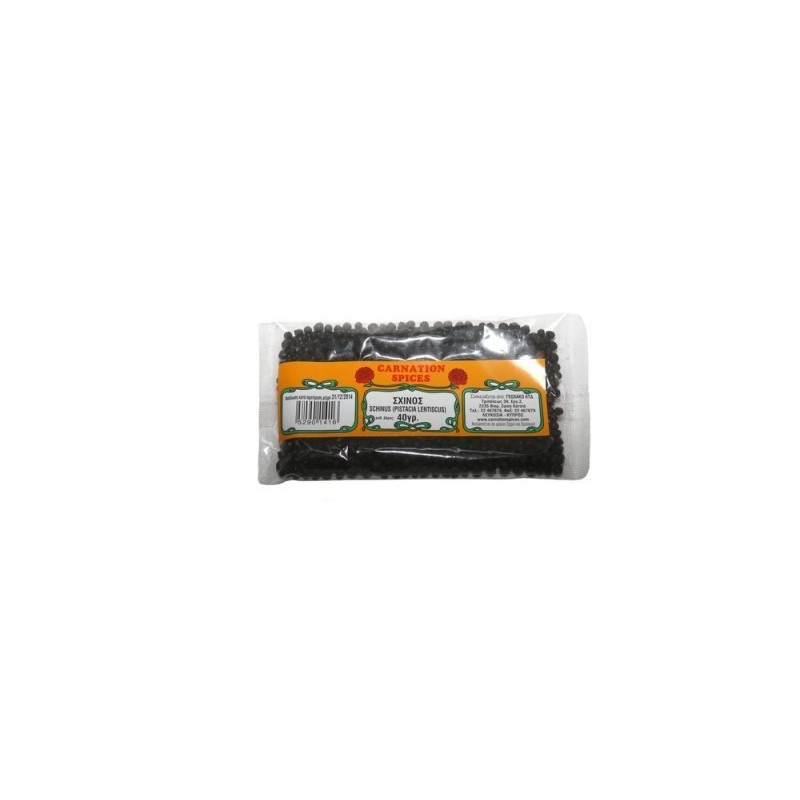
Brand: Lays (Corina Snacks Ltd)
Lays Oregano Potato Chips Crisps 45g
Lays Oregano Potato Chips Crisps 45g
Brand: Lays (Corina Snacks Ltd)
Lays Oregano Potato Chips Crisps 45g
Brand: Lays (Corina Snacks Ltd)
Lays Cheetos Dracoulinia 30gDelicious corn snacks with a slightly spicy Greek tomato flavour. They are called Dracoulinia as they have the shape of Dracula's fangs!
Brand: Lays (Corina Snacks Ltd)
Lays Cheetos Pizza 34g Corn snacks with Pizza flavour.
Brand: Lays (Corina Snacks Ltd)
Lays Prawn Cocktail Potato Chips Crisps 45
Brand: Lays (Corina Snacks Ltd)
Lays Cheetos Pacotinia 40g Corn snacks with real cheese coating.
Payment methods



Carnation Shinos Schinus Pistacia Lentiscus 40g
Carnation Shinos Schinus Pistacia Lentiscus 40g
Used as a spice in Cypriot village sausages Loukanika. The shinos seed, scientifically known as Schinus Pistacia Lentiscus, is the seed of the Shinia bush. The seeds are black in colour and they look similar to black pepper corns.
Recipe for Cypriot village sausages Loukanika
1kg pork shoulder cut into small cubes (meat and fat together)
3-4 tbs crushed coriander
3-4 tbs salt
1 & 1/2 tbs whole “schinus” (or “shinos”) (Note: whole “shinos” looks like black peppercorns, but are not. They also are not pink peppercorns. They are also not juniper berries. “Shinia” come from a plant indigenous to the Mediterranean called pistacia lentiscus in Latin, so it’s best to ask a speciality store for direction when buying these because it’s a very specific type of dried berry that is needed.)
1 & 1/2 tsps freshly ground black pepper
dry red wine (you will need a few bottles, see below for instructions)
2 pork intestines (cleaned and ready to be used). Tell your butcher you have diced 1kg of meat, and ask how many pork intestines you will need.
1. In a large bowl place the chopped meat, sprinkle 1 tbs salt and add enough red wine to cover the meat completely.
2. Cover and place it in the refrigerator. Every day for 8 days, stir and add about a 1/4 cup to 1/2 cup more wine. During this time, the meat will soak up the wine.
3. On the last day (8th day – e.g. Saturday to Saturday) take some of the wine out of the bowl, add salt, pepper, coriander, and whole “schinus”.
4. Stir the mixture. It is now ready to be stuffed into the intestines. You may need to create a “funnel” at the top of the intestine. (A trick is to get a little bendable twig, and make a circle with it, tie the two ends together. Then, put an open end of the intestine around this to make a firm opening. Also, if the intestines are long cut them in half, it will be easier to stuff and form the sausages.) Tie a knot at the other end of the intestine.
5. Begin to stuff the intestine with the sausage mixture. Once all the mixture has been stuffed into the intestine, tie a knot at the end.
6. Then create individual sausages. We made our sausages about 10 cm long, but you can also make them smaller. To make an individual sausage, simply twist the intestine to create a sausage.
7. Then, hang the sausages to dry in the sun for 2 weeks. (Bring them in at night and if it rains, otherwise leave them outside in the sun). Note that traditionally, people would “dry out” their “loukanika” by smoking them over the fireplace – sometimes burning the branches from wild juniper bushes. But, if you are making “loukanika” in a city, this won’t really be possible.
8. Once the sausages are dry, they are ready to be cooked. Serve them hot, cooked on charcoals, or fried with eggs, and together with (grilled) halloumi and tomato. (Note that the picture below is of the “loukanika” once they have been dried in the sun for 2 weeks. It’s not very appetizing but they taste really good – I promise!)
Brand: Carnation Spices & Herbs
Carnation Whole Mahlep Mehlepi 10g
Brand: Carnation Spices & Herbs
Carnation Gum Mastic Mastiha Ground with Maize Starch 9g
Brand: Nestle
Maggi Vegetable Bouillon Stock Cubes 132g
Halloumi Making Rennet Pytia 15g Rennet or Pytia (Πυτιά) Greek is used to curdle the milk to make Halloumi. Traditional halloumi is made from unpasteurised sheep and goat milk.
Brand: Carnation Spices & Herbs
Carnation Ground Mahlep Mehlepi 10g
Brand: Carnation Spices & Herbs
Carnation Gum Mastic Whole Mastiha Dakry 9g
Your review appreciation cannot be sent
Report comment
Report sent
Your report cannot be sent
Write your review
Review sent
Your review cannot be sent

Carnation Shinos Schinus Pistacia Lentiscus 40g